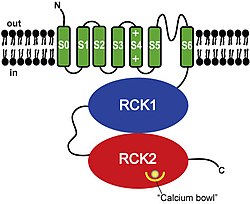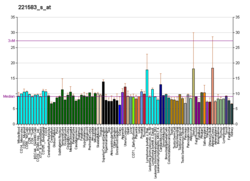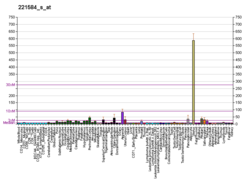Potassium_large_conductance_calcium-activated_channel,_subfamily_M,_alpha_1
Calcium-activated potassium channel subunit alpha-1
Voltage-gated potassium channel protein
Calcium-activated potassium channel subunit alpha-1 also known as large conductance calcium-activated potassium channel, subfamily M, alpha member 1 (KCa1.1), or BK channel alpha subunit,[5] is a voltage gated potassium channel encoded by the KCNMA1 gene and characterized by their large conductance of potassium ions (K+) through cell membranes.[6]
BK channels are activated (opened) by changes in membrane electrical potential and/or by increases in concentration of intracellular calcium ion (Ca2+).[7][8] Opening of BK channels allows K+ to passively flow through the channel, down the electrochemical gradient. Under typical physiological conditions, this results in an efflux of K+ from the cell, which leads to cell membrane hyperpolarization (a decrease in the electrical potential across the cell membrane) and a decrease in cell excitability (a decrease in the probability that the cell will transmit an action potential).
BK channels are essential for the regulation of several key physiological processes including smooth muscle tone and neuronal excitability.[6] They control the contraction of smooth muscle and are involved with the electrical tuning of hair cells in the cochlea. BK channels also contribute to the behavioral effects of ethanol in the worm C. elegans under high concentrations (> 100 mM, or approximately 0.50% BAC).[9] It remains to be determined if BK channels contribute to intoxication in humans.
BK channels have a tetrameric structure. Each monomer of the channel-forming alpha subunit is the product of the KCNMA1 gene. Modulatory beta subunits (encoded by KCNMB1, KCNMB2, KCNMB3, or KCNMB4) can associate with the tetrameric channel. Alternatively spliced transcript variants encoding different isoforms have been identified.[6]
Each BK channel alpha subunit consists of (from N- to C-terminal):
- A unique transmembrane domain (S0)[10] that precedes the 6 transmembrane domains (S1-S6) conserved in all voltage-dependent K+ channels.
- A voltage sensing domain (S1-S4).
- A K+ channel pore domain (S5, selectivity filter, and S6).
- A cytoplasmic C-terminal domain (CTD) consisting of a pair of RCK domains that assemble into an octameric gating ring on the intracellular side of the tetrameric channel.[8][11][12][13][14][15][16] The CTD contains four primary binding sites for Ca2+, called "calcium bowls", encoded within the second RCK domain of each monomer.[8][11][15][16]
| Calcium-activated BK potassium channel alpha subunit | |||||||||
|---|---|---|---|---|---|---|---|---|---|
| Identifiers | |||||||||
| Symbol | BK_channel_a | ||||||||
| Pfam | PF03493 | ||||||||
| InterPro | IPR003929 | ||||||||
| |||||||||
Available X-ray structures include:
BK channels are pharmacological targets for the treatment of stroke. Various pharmaceutical companies developed synthetic molecules activating these channels[17] in order to prevent excessive neurotoxic calcium entry in neurons.[18] But BMS-204352 (MaxiPost) a molecule developed by Bristol-Myers Squibb failed to improve clinical outcome in stroke patients compared to placebo.[19] BK channels have also been found to be activated by exogenous pollutants and endogenous gasotransmitters carbon monoxide[20][21] and hydrogen sulphide.[22]
BK channels are blocked by tetraethylammonium (TEA), paxilline[23] and iberiotoxin.[24]
Researchers have identified a rare disease in humans caused by mutations in the gene. KCNMA1-linked channelopathy can cause neurological conditions like seizures and movement disorders.[25] An episode of the Diagnosis TV show, based on a column in the New York Times, was about a young girl with a KCNMA1 disorder that caused transient episodes of muscle weakness.[26]
- "Human PubMed Reference:". National Center for Biotechnology Information, U.S. National Library of Medicine.
- "Mouse PubMed Reference:". National Center for Biotechnology Information, U.S. National Library of Medicine.
- "HomoloGene - NCBI". www.ncbi.nlm.nih.gov.
- Miller C (2000). "An overview of the potassium channel family". Genome Biology. 1 (4): REVIEWS0004. doi:10.1186/gb-2000-1-4-reviews0004. PMC 138870. PMID 11178249.
- Yuan P, Leonetti MD, Pico AR, Hsiung Y, MacKinnon R (July 2010). "Structure of the human BK channel Ca2+-activation apparatus at 3.0 A resolution". Science. 329 (5988): 182–6. Bibcode:2010Sci...329..182Y. doi:10.1126/science.1190414. PMC 3022345. PMID 20508092.
- Davies AG, Pierce-Shimomura JT, Kim H, VanHoven MK, Thiele TR, Bonci A, et al. (December 2003). "A central role of the BK potassium channel in behavioral responses to ethanol in C. elegans". Cell. 115 (6): 655–66. doi:10.1016/S0092-8674(03)00979-6. PMID 14675531. S2CID 8120562.
- Wallner M, Meera P, Toro L (December 1996). "Determinant for beta-subunit regulation in high-conductance voltage-activated and Ca(2+)-sensitive K+ channels: an additional transmembrane region at the N terminus". Proceedings of the National Academy of Sciences of the United States of America. 93 (25): 14922–7. Bibcode:1996PNAS...9314922W. doi:10.1073/pnas.93.25.14922. PMC 26238. PMID 8962157.
- Wu Y, Yang Y, Ye S, Jiang Y (July 2010). "Structure of the gating ring from the human large-conductance Ca(2+)-gated K(+) channel". Nature. 466 (7304): 393–7. Bibcode:2010Natur.466..393W. doi:10.1038/nature09252. PMC 2910425. PMID 20574420.
- Jiang Y, Pico A, Cadene M, Chait BT, MacKinnon R (March 2001). "Structure of the RCK domain from the E. coli K+ channel and demonstration of its presence in the human BK channel". Neuron. 29 (3): 593–601. doi:10.1016/S0896-6273(01)00236-7. PMID 11301020. S2CID 17880955.
- Pico A. 2003. RCK domain model of calcium activation in BK channels. PhD thesis. The Rockfeller University, New York.
- Yusifov T, Savalli N, Gandhi CS, Ottolia M, Olcese R (January 2008). "The RCK2 domain of the human BKCa channel is a calcium sensor". Proceedings of the National Academy of Sciences of the United States of America. 105 (1): 376–81. Bibcode:2008PNAS..105..376Y. doi:10.1073/pnas.0705261105. PMC 2224220. PMID 18162557.
- Schreiber M, Salkoff L (September 1997). "A novel calcium-sensing domain in the BK channel". Biophysical Journal. 73 (3): 1355–63. Bibcode:1997BpJ....73.1355S. doi:10.1016/S0006-3495(97)78168-2. PMC 1181035. PMID 9284303.
- Yuan P, Leonetti MD, Hsiung Y, MacKinnon R (December 2011). "Open structure of the Ca2+ gating ring in the high-conductance Ca2+-activated K+ channel". Nature. 481 (7379): 94–7. Bibcode:2012Natur.481...94Y. doi:10.1038/nature10670. PMC 3319005. PMID 22139424.
- Jensen BS (2002). "BMS-204352: a potassium channel opener developed for the treatment of stroke". CNS Drug Reviews. 8 (4): 353–60. doi:10.1111/j.1527-3458.2002.tb00233.x. PMC 6741660. PMID 12481191.
- Dubuis E, Potier M, Wang R, Vandier C (February 2005). "Continuous inhalation of carbon monoxide attenuates hypoxic pulmonary hypertension development presumably through activation of BKCa channels". Cardiovascular Research. 65 (3): 751–61. doi:10.1016/j.cardiores.2004.11.007. PMID 15664403.
- Hou S, Xu R, Heinemann SH, Hoshi T (March 2008). "The RCK1 high-affinity Ca2+ sensor confers carbon monoxide sensitivity to Slo1 BK channels". Proceedings of the National Academy of Sciences of the United States of America. 105 (10): 4039–43. Bibcode:2008PNAS..105.4039H. doi:10.1073/pnas.0800304105. PMC 2268785. PMID 18316727.
- Candia S, Garcia ML, Latorre R (August 1992). "Mode of action of iberiotoxin, a potent blocker of the large conductance Ca(2+)-activated K+ channel". Biophysical Journal. 63 (2): 583–90. Bibcode:1992BpJ....63..583C. doi:10.1016/S0006-3495(92)81630-2. PMC 1262182. PMID 1384740.
- Bailey CS, Moldenhauer HJ, Park SM, Keros S, Meredith AL (October 2019). "KCNMA1-linked channelopathy". The Journal of General Physiology. 151 (10): 1173–1189. doi:10.1085/jgp.201912457. PMC 6785733. PMID 31427379.
- Sanders L (2018-09-11). "A Diagnosis Update: New Information on a Young Girl's Rare Genetic Condition". The New York Times. Retrieved 2019-11-02.
- Magleby KL (February 2003). "Gating mechanism of BK (Slo1) channels: so near, yet so far". The Journal of General Physiology. 121 (2): 81–96. doi:10.1085/jgp.20028721. PMC 2217328. PMID 12566537.
- Wei AD, Gutman GA, Aldrich R, Chandy KG, Grissmer S, Wulff H (December 2005). "International Union of Pharmacology. LII. Nomenclature and molecular relationships of calcium-activated potassium channels". Pharmacological Reviews. 57 (4): 463–72. doi:10.1124/pr.57.4.9. PMID 16382103. S2CID 8290401.
- McCobb DP, Fowler NL, Featherstone T, Lingle CJ, Saito M, Krause JE, Salkoff L (September 1995). "A human calcium-activated potassium channel gene expressed in vascular smooth muscle". The American Journal of Physiology. 269 (3 Pt 2): H767-77. doi:10.1152/ajpheart.1995.269.3.H767. PMID 7573516.
- Butler A, Tsunoda S, McCobb DP, Wei A, Salkoff L (July 1993). "mSlo, a complex mouse gene encoding "maxi" calcium-activated potassium channels". Science. 261 (5118): 221–4. Bibcode:1993Sci...261..221B. doi:10.1126/science.7687074. PMID 7687074.
- Dworetzky SI, Trojnacki JT, Gribkoff VK (November 1994). "Cloning and expression of a human large-conductance calcium-activated potassium channel". Brain Research. Molecular Brain Research. 27 (1): 189–93. doi:10.1016/0169-328X(94)90203-8. PMID 7877450.
- Pallanck L, Ganetzky B (August 1994). "Cloning and characterization of human and mouse homologs of the Drosophila calcium-activated potassium channel gene, slowpoke". Human Molecular Genetics. 3 (8): 1239–43. doi:10.1093/hmg/3.8.1239. PMID 7987297.
- Tseng-Crank J, Foster CD, Krause JD, Mertz R, Godinot N, DiChiara TJ, Reinhart PH (December 1994). "Cloning, expression, and distribution of functionally distinct Ca(2+)-activated K+ channel isoforms from human brain". Neuron. 13 (6): 1315–30. doi:10.1016/0896-6273(94)90418-9. PMID 7993625. S2CID 31170819.
- Knaus HG, Folander K, Garcia-Calvo M, Garcia ML, Kaczorowski GJ, Smith M, Swanson R (June 1994). "Primary sequence and immunological characterization of beta-subunit of high conductance Ca(2+)-activated K+ channel from smooth muscle". The Journal of Biological Chemistry. 269 (25): 17274–8. doi:10.1016/S0021-9258(17)32551-6. PMID 8006036.
- Meera P, Wallner M, Jiang Z, Toro L (March 1996). "A calcium switch for the functional coupling between alpha (hslo) and beta subunits (KV,Ca beta) of maxi K channels". FEBS Letters. 382 (1–2): 84–8. doi:10.1016/0014-5793(96)00151-2. PMID 8612769. S2CID 81684849.
- Wallner M, Meera P, Ottolia M, Kaczorowski GJ, Latorre R, Garcia ML, et al. (1996). "Characterization of and modulation by a beta-subunit of a human maxi KCa channel cloned from myometrium". Receptors & Channels. 3 (3): 185–99. PMID 8821792.
- Meera P, Wallner M, Song M, Toro L (December 1997). "Large conductance voltage- and calcium-dependent K+ channel, a distinct member of voltage-dependent ion channels with seven N-terminal transmembrane segments (S0-S6), an extracellular N terminus, and an intracellular (S9-S10) C terminus". Proceedings of the National Academy of Sciences of the United States of America. 94 (25): 14066–71. Bibcode:1997PNAS...9414066M. doi:10.1073/pnas.94.25.14066. PMC 28433. PMID 9391153.
- Díaz L, Meera P, Amigo J, Stefani E, Alvarez O, Toro L, Latorre R (December 1998). "Role of the S4 segment in a voltage-dependent calcium-sensitive potassium (hSlo) channel". The Journal of Biological Chemistry. 273 (49): 32430–6. doi:10.1074/jbc.273.49.32430. PMID 9829973.
- Wallner M, Meera P, Toro L (March 1999). "Molecular basis of fast inactivation in voltage and Ca2+-activated K+ channels: a transmembrane beta-subunit homolog". Proceedings of the National Academy of Sciences of the United States of America. 96 (7): 4137–42. Bibcode:1999PNAS...96.4137W. doi:10.1073/pnas.96.7.4137. PMC 22433. PMID 10097176.
- Valverde MA, Rojas P, Amigo J, Cosmelli D, Orio P, Bahamonde MI, et al. (September 1999). "Acute activation of Maxi-K channels (hSlo) by estradiol binding to the beta subunit". Science. 285 (5435): 1929–31. doi:10.1126/science.285.5435.1929. PMID 10489376.
- Brenner R, Jegla TJ, Wickenden A, Liu Y, Aldrich RW (March 2000). "Cloning and functional characterization of novel large conductance calcium-activated potassium channel beta subunits, hKCNMB3 and hKCNMB4". The Journal of Biological Chemistry. 275 (9): 6453–61. doi:10.1074/jbc.275.9.6453. PMID 10692449.
- Liu QH, Williams DA, McManus C, Baribaud F, Doms RW, Schols D, et al. (April 2000). "HIV-1 gp120 and chemokines activate ion channels in primary macrophages through CCR5 and CXCR4 stimulation". Proceedings of the National Academy of Sciences of the United States of America. 97 (9): 4832–7. Bibcode:2000PNAS...97.4832L. doi:10.1073/pnas.090521697. PMC 18318. PMID 10758170.
- Quirk JC, Reinhart PH (October 2001). "Identification of a novel tetramerization domain in large conductance K(ca) channels". Neuron. 32 (1): 13–23. doi:10.1016/S0896-6273(01)00444-5. PMID 11604135. S2CID 18208592.
- Soto MA, González C, Lissi E, Vergara C, Latorre R (March 2002). "Ca(2+)-activated K+ channel inhibition by reactive oxygen species". American Journal of Physiology. Cell Physiology. 282 (3): C461-71. doi:10.1152/ajpcell.00167.2001. hdl:10533/172864. PMID 11832330.
- Wang YW, Ding JP, Xia XM, Lingle CJ (March 2002). "Consequences of the stoichiometry of Slo1 alpha and auxiliary beta subunits on functional properties of large-conductance Ca2+-activated K+ channels". The Journal of Neuroscience. 22 (5): 1550–61. doi:10.1523/JNEUROSCI.22-05-01550.2002. PMC 6758889. PMID 11880485.







